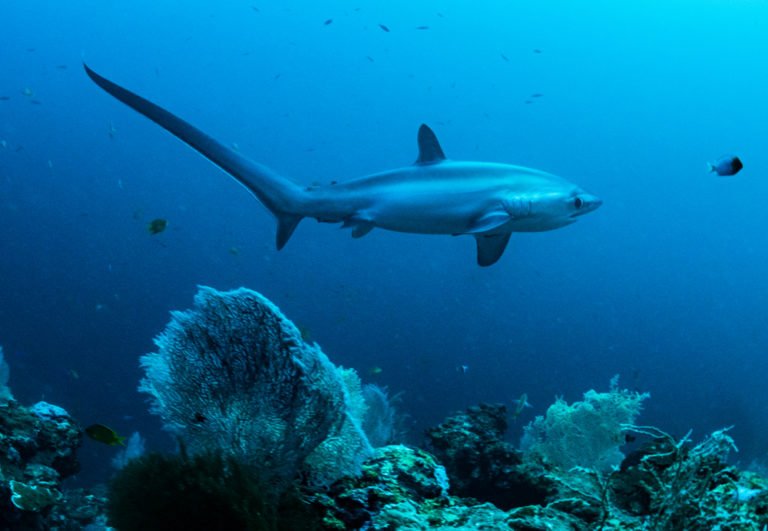Species Spotlight: Thresher Sharks

Thresher Sharks are an extremely unique species of shark. Their anatomy and behavior are very unusual for sharks. Thresher Sharks are warm blooded and endothermic. Their blood and body are warmer than the surrounding waters. Being warm-blooded helps them use their muscles more efficiently. Their endothermic capabilities make them fast swimmers and swift predators.
The three species of this shark, Pelagic, Bigeye and Common are difficult to tell apart. Among the three, the Pelagic and Bigeye are most similar, and the Common Thresher is most seen when diving. There is a possibility of a fourth Thresher Shark species, but shark experts have not confirmed their existence.
What do Thresher Sharks look like?
Thresher Sharks are metallic brown, gray, blue-gray or black on the back and under their snout. The sides of a Thresher Shark are lighter with a white belly. This shark has a very characteristic dorsal fin and pelvic fins which the shark is named after. The fins of the shark are black, and some have white spots on the tips. Their tail fin (caudal fin) is sickle-shaped, and the upper part is about half as long as the length of the shark.
Thresher Sharks can grow to lengths of up to 18 feet with a life span of 19 and 50 years. Thresher Sharks mate in midsummer and their eggs are fertilized internally and develop inside the female. After 9 months of gestation, females bear two to four live pups. There is a special phenomenon called “oophagy” in the womb. The pups leave their eggs, still in the womb, and feed themselves with all the unfertilized eggs.
How do Thresher Sharks hunt for food?
Thresher Sharks are considered a very athletic shark and known for slaying their prey with their huge tails. This shark has a special jumping technique called breaching where they jump out of the water and up to ten feet into the air. While hunting, they launch themselves out of the water and perform wild turns. They love to hunt schools of fish in the open Ocean waters and prefer Tuna, and Mackerels. Thresher Sharks have small, curved, smooth, razor-sharp teeth. They feed on small fish including sardines, hake, mackerel, and squid. Once the prey is in their vicinity, they will smack it with their tail repeatedly until it is incapacitated. Then, the Thresher will attack the prey with speed assault, taking bites on each attack until the food has been completely devoured.

Where do Thresher Sharks live?
Thresher Sharks are solitary creatures. It is not known why but The Indian Ocean is the only place where Thresher Sharks have been seen in packs. Thresher Sharks dwell in warm and temperate waters around the world. They are highly migratory, and travel seasonally as the temperature changes. Thresher Sharks favor the open, deep waters of the Eastern Pacific Ocean. Seasonally, they migrate between Washington and Mexico. They prefer cooler waters but can be found in coastal areas. These areas are rich with plankton which Threshers enjoy feeding upon.
Are Thresher Sharks extinct?
Predators of the Thresher shark include Killer whales and large sharks but more often, Threshers are often victims of fishing nets. The Thresher Sharks are not consumed in the United States, but in other parts of the world considered a value for their meat, liver, hide and fins. The Thresher Shark is a sought-after gamefish. They are hunted for their fins, liver oil, tails, and flesh. Due to the reduction in the Thresher Sharks population, new laws are being passed to protect the future of this species.
Diving with the Thresher Shark.
Thresher Sharks are harmless to humans. Being smacked with the Threshers enormous tail is the largest threat of injury to a diver. They are shy and fearful of humans and will swim away the moment they see a diver. They are frightened by the bubbles from scuba diving gear or any sudden movement. The Thresher Shark is one of the fastest sharks in the world clocking speeds of 20 to 30 miles per hour. This makes it one of the fastest predators in the ocean.
To guarantee the ability to see Thresher Sharks on future dives, please observe the following guidelines:
- Dive in the early morning hours.
- Be prepared to dive in deeper waters.
- Try to avoid sudden movements. Stay calm and quiet.
- Do not chase the shark.
- Do not touch the shark.
- Do not direct camera flashes into the sharks’ eyes as they have extremely sensitive eyes.
Thinking about adding the Thresher Shark to your diving experience, these are some of the best areas to spend quality time with them.
- Philippines: Malapascua Island and Pescador Island
- Red Sea, Egypt: Big Brother
- Indonesia: Alor and Bali
- Maldives: Fuvahmulah
- Australia, Great Barrier Reef: Osprey Reef
Diving with the Thresher Shark will not disappoint. They are excellent sharks to interact with as a first-time shark diver. The Thresher Shark extremely calm nature and unaggressive behavior make them perfect for enjoying. Encountering these beautiful, graceful creatures is a truly magical experience.
